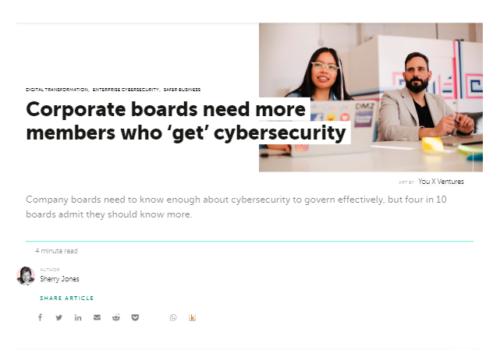Text transcription
ICYMI: Transforming the Customer Experience Casey Coleman, FedScoop November 15, 2017
Too often in the public sector, technology falls short of providing quality public service. Citizens expect more and better online access to their governments, but many agencies, hamstrung by tight budgets, fail to satisfy them. At the same time, agency IT leaders may struggle to comply with continually changing government rules and regulations. The reason: Their legacy systems are woefully out-of-date. According to a 2016 General Accounting Ofice report, many U.S. agencies are using old technology — more than 50 years old, in some cases. And with 75 percent or more of agency IT budgets going to operations and maintenance of these aged systems, upgrading may seem an impossible dream. How are agencies to properly serve the public and meet regulations without spending huge amounts to replace entire systems? For IT leaders and agency heads, this question poses a true “digital dilemma.” Technology has served governments well for many years. The U.S. Department of Defense, in fact, helped create technologies many of us take for granted, including the internet and GPS. But the routers, computers, data storage systems and other technology infrastructure used today were installed for in-house use, often on top of older systems, and designed for an earlier era of large-scale record-keeping and other business functions. Those technologies worked great at the time and were considered state-of-the-art. Just as a new car is said to lose value the instant it leaves the sales lot, however, computing systems lost their cutting edge as soon as they got switched on. This “ instant obsolescence” plagues technologies today, as well. In a time when technology is literally in everyone’s hands, people expect anytime, anywhere access to information and to simple ways to pay fees and fines, or receive alerts and emergency notifications, among other things — all in real time. How will a system built in the 1970s provide these services? Or, conversely, how can IT leaders keep even newer, incredibly complex government systems up to date and secure while also maintaining older equipment?
Giving New Life to Legacy Systems
Doing business in the cloud can resolve all these issues. Cloud providers, and the services they provide, can offer a “future-proof” environment. They continually update and patch the servers, software and platforms they manage so agencies don’t have to — and without the inconvenience of system down time. Moving to the cloud means agencies always have the latest, greatest technologies at their fingertips. What’s more, using the cloud gives new life to legacy systems by providing a virtual “sandbox” in which IT developers and designers can innovate ways to meet citizens’ needs. We can see a great example in that with A mtrak, which embarked on an enterprise-wide transformation focused on the customer experience that included everything from window- clad observation cars to a digital technology infrastructure. As Amtrak moved from mainframes to client servers to cloud service providers, it needed applications simple enough for a diverse, mobile, nontechnical workforce to adopt without extensive training. With help from Salesforce, Amtrak developed an app called TOPS that tracks train servicing, enabling supervisors to log when a team has completed a given service, alert counterparts of any issues or delays and pull reports that capture performance stats, common disruptions and more. The TOPS app opened up communications and visibility across the entire train turnover process, making it easier to understand, quantify and replicate best practices. Amtrak’s efforts also illustrate how organizations can move beyond reinventing old systems and instead build engagement layers on top of them. This mix of the old and the new technology platforms enabled Amtrak to leverage the value of long-time employees’ knowledge, steeped in legacy systems, as well as experiences of newer hires, who tend to be more familiar with modern approaches. Amtrak’s forward-thinking approach is a great example of how to upgrade the quality of the customer and employee experience, delivering for both customers and the mission. Cloud technology makes innovation possible in governments everywhere, without the need for an expensive overhaul. It also provides an inexpensive, relatively low-risk way to test tech modernization pilot programs or simplify IT operations and experience the benefits and potential problem spots first-hand.
Where to Start?
While deciding where to start can sometimes feel like a daunting task, why not focus first on the customer experience? Gartner’s “Bi-Modal IT Projects” approach suggests prioritizing public-facing “systems of differentiation” that set the agency apart from competitors and “systems of innovation” over “systems of record.” Payroll and inventory systems may be fine as is, but are citizens getting their questions answered in the moment 24/7? If there’s no app for that, maybe it’s time to build one. “The care of human life and happiness … is the first and only legitimate object of good government,” Thomas Jefferson said. Governments exist to serve, and workers tend to choose agency jobs out of an ethos of service: They want to give back. To truly serve a tech-centered society, the public sector must be able to meet people where they live and work: on their digital devices. Fortunately, upgrading legacy systems and keeping them up-to-date is simpler today than ever before. How will your agency resolve the “digital dilemma”? For more ideas on how your agency can capitalize on digital tools for improving the customer experience, check out my discussion with Paul Greenberg, known as “The Godfather of CRM,” on the power of digital government, at this on-demand webinar. Casey Coleman leads Salesforce’s Global Government Solutions business. Previously, as CIO at the U.S. General Services Administrations, she successfully drove the integration of GSA’s infrastructure operations into a single program and led the first federal migration to a cloud- based email and collaboration platform.
Project Details
I ghostwrote this post for Casey Coleman at Salesforce, one of three I wrote in collaboration with her after phone interviews. Client: FEDScoop Format: Article







